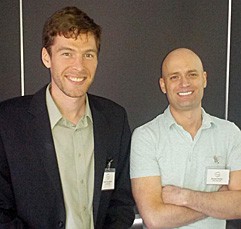If you have remained in the wider peer to peer lending conversation for the past year or so, you have come to see the general picture that is unfolding. On the one side you have the lending companies, Lending Club and Prosper, who have created exchanges that enable a freer flow of capital between investors and borrowers. On the other side you have sites by investors themselves, from tool/statistics sites to news and commentary sites. And this is how the conversation continues to progress. The platforms issue another month of loans, usually with a few notable changes from the previous month, and this issuance recatalyzes a conversation that moves in waves across the web.
Speaking about my own experience, this dynamic has been really enjoyable to witness. Different parties come and go, the platforms sometimes change, but the rhythm has remained. To boot, the conversation is remarkable for its overall candor. Yes, there are people out there who are quite critical of peer to peer lending, who cite it as an unstable bubble or whatnot, but the national consensus has decided that this asset class is a good thing, and you can see that in the relationships that have formed within its ecosystem.
Here’s something: almost all of the people in this conversation get along. For example, Ryan Lichtenwald launched PeerSocialLending in May, and in six months his site has already been referenced by the rest. There are exceptions of course (like the API vs. screen scraping divide), but on the whole this wider group of interested individuals is generally eager to hear what one another have to say.
And this is what makes it so refreshing to cover. Peer to peer lending contains so much latent possibility for the future of national finance that a refreshing abundance-mentality has almost been woven into its DNA.
 There is another variable at play, which is the leadership of Peter Renton, the person behind Lend Academy and the most experienced voice of us all. Peter makes no apologies for being a cheerleader for this asset class, and I think it is fair to say that his persistent encouragement has sort of engendered a spirit of applause within the wider dialog.
There is another variable at play, which is the leadership of Peter Renton, the person behind Lend Academy and the most experienced voice of us all. Peter makes no apologies for being a cheerleader for this asset class, and I think it is fair to say that his persistent encouragement has sort of engendered a spirit of applause within the wider dialog.
In short, peer to peer lending has become a joy to watch and write about – both for the latent possibility it possesses, as well as for the general candor of its participants. The only struggle, of course, has been how electronic this whole thing is. While an online-only approach to issuing loans has helped keep overall platform costs low, cutting out the banks and giving lower rates to borrowers than ever before, it has the negative side-effect of also keeping us behind our computer screens. And while online-only loan issuers and online-only investor voices have accomplished a great deal, there remains a great need to have a gathering per year where we can meet face to face and actualize this thing that is happening.

LendIt 2013: Michael from NSR looking like a stud (and me needing a haircut)
The LendIt Conference, founded by Lend Academy, Nowstreet and Disruption Credit, has become that exact opportunity, and in two months it will be happening again. May 5-6 will bring all of peer to peer lending’s voices under one roof in San Francisco. Lending Club and Prosper, typically just dot-coms on some unseen server rack somewhere, will arrive as real people – people eager to listen and share the work they have done. Programmers like Michael Philips of NickelSteamroller will share lunch with statisticians like Bryce Mason of P2P-Picks. Cocktails will be sipped, information will be passed around, and a generalized consensus will form about what this whole thing is and where it is going.
I attended LendIt in June last year. Here are my personal highlights:
- Lending Club’s CEO Renaud Laplanche started things off with a great morning keynote on how technology is adopted (video)
- Lending Club and Prosper actually sat down and had a conversation together, which rarely happens
- Michael Philips from NickelSteamroller gave a presentation on how both companies differ in their investor API
- Getting to meet cash-lined institutional players, many who turned out to be authentic and personable people
- Meeting great people for the first time: Dara Albright, Matt Symons, Brendan Ross, Howard Freedland, Matt Burton, and James Jones
- Feeling the excitement in the room while learning a lot of new information
In summary, peer to peer lending happens on the web. The internet is the foundation of why this is all possible. However, at its core this foundation is really just a network of people, people who are working hard to transform the banking industry into something more stable and simple. For those of you who are as fascinated by this trend as I am, the chance to attend the LendIt on May 5-6 is an unprecedented opportunity to leave the internet behind and experience the faces and voices of this revolution first hand.
Hope to see you there,
Simon
Register: LendIt 2014 (15% discount for LendingMemo readers! Coupon code: LMDISC)
[image credit: Germán Póo-Caamaño “Bay Bridge at Night”
CC-BY 2.0]

Hi Simon, Thanks for a great article. I also really enjoy getting together face to face with people and LendIt is the perfect place for that. I just wanted to clarify one thing. LendIt was founded not just by me, it was a collaboration between three organizations: Lend Academy, Nowstreet and Disruption Credit.
Thanks Peter. Updated.